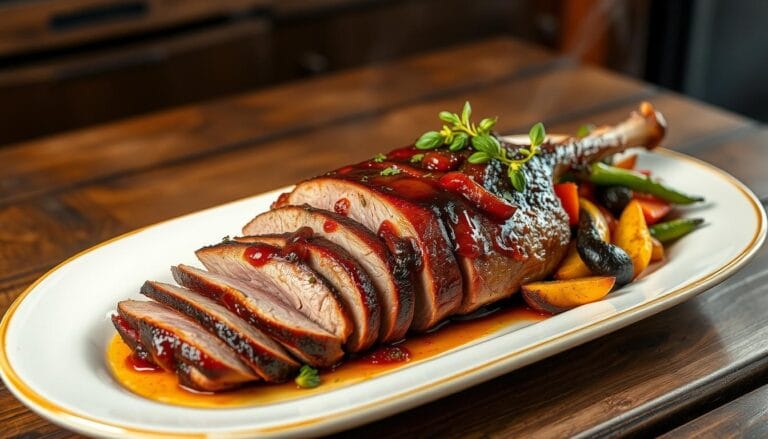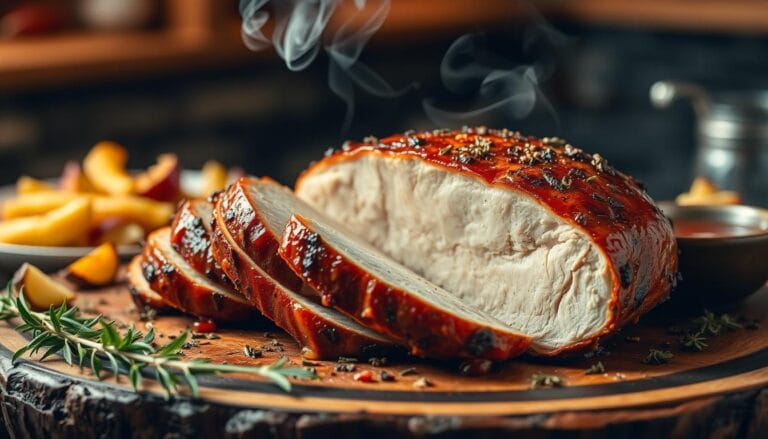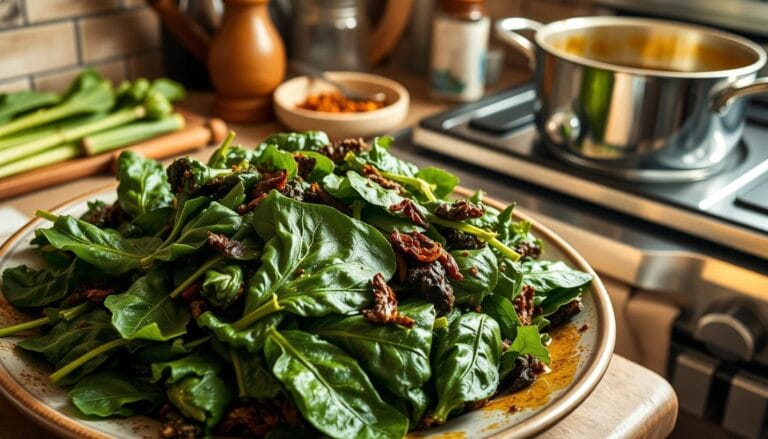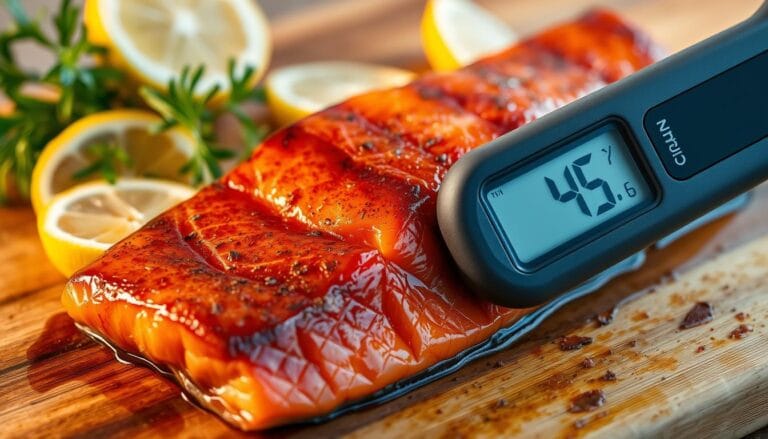Smoked Chicken Breast: 7 Secrets to Mouthwatering Flavor
Are you tired of bland, dry barbecue chicken? It leaves your taste buds wanting more. Imagine turning an ordinary smoked chicken breast into a dish that everyone will love.
Smoking chicken is more than just cooking—it’s an art. It turns simple protein into a flavorful feast. Whether you love BBQ or grilling, learning to smoke chicken can make you a master.
This guide will share seven key techniques for better barbecue chicken. You’ll learn about the best wood chips and how to control temperature. Your smoked chicken will be juicy, smoky, and a hit with everyone.
Get ready to improve your grilling skills. Your smoked chicken will be the highlight of every BBQ.
Table of Contents
Essential Equipment for Perfect Smoked Chicken
Smoking chicken is an art that needs the right tools. These tools turn a simple meal into a masterpiece. To become a meat smoker expert, you must know the essential equipment.
Types of Smokers for Poultry
Choosing the right smoker is key for perfect chicken. Each type has its own benefits:
- Electric Smokers: Easy to use and keeps temperature steady
- Propane Smokers: Portable and heats up fast
- Charcoal Smokers: Offers a traditional smoky taste
- Pellet Smokers: Mixes convenience with wood-fired flavor
Temperature Control Tools
Smoking needs precision. Here are the must-have tools for temperature control:
- Digital instant-read thermometers
- Wireless probe thermometers
- Ambient temperature gauges
Wood Selection Guide
Wood chips greatly affect your chicken’s taste. Most smokers prefer mild woods like applewood and cherry. Your choice can make or break the dish.
| Wood Type | Flavor Profile | Intensity |
|---|---|---|
| Applewood | Sweet, Mild | Low |
| Hickory | Strong, Bacon-like | High |
| Cherry | Fruity, Subtle | Medium |
The Science Behind Brining Your Chicken Breast
Brining is a technique that makes your chicken marinade amazing. It changes the game. When you learn about brining, you discover how to make your chicken juicy and full of flavor.
Brining works by a cool process called osmosis. Salt gets into the chicken’s muscle fibers. This helps the chicken keep more moisture when it’s cooked. So, your chicken stays tender and juicy, even when it’s hot.
“Brining is like a flavor insurance policy for your chicken” – Professional Pit Master
Here are some key brining tips:
- Optimal brining time for chicken breasts: 30 to 60 minutes
- Salt-to-water ratio: 4 cups water to 6 tablespoons kosher salt
- Benefits include enhanced moisture and deeper flavor penetration
Your brining plan is crucial. A 15-minute brine adds a light touch, while a 1-hour brine makes the meat perfectly seasoned. But don’t brine for more than 2 hours, or the chicken will be too salty.
For the best results, keep your chicken in the fridge while it’s brining. This keeps it safe and lets the salt work its magic without growing bacteria.
Pro tip: Always pat your chicken dry after brining to achieve that perfect smoky exterior!
How to Prepare Smoked Chicken Breast
Preparing smoked chicken breast needs careful attention. It’s a healthy protein dish that requires precision. Follow these expert tips to make your chicken recipes shine with flavor and juiciness.
Before you start smoking, you must prepare a few key steps. These steps turn an ordinary chicken breast into a culinary masterpiece.
Trimming and Preparation Tips
- Remove excess fat and loose membrane from chicken breasts
- Pat chicken completely dry with paper towels
- Trim uneven edges for consistent cooking
- Select uniform-sized chicken breasts for even smoking
Dry Brine vs. Wet Brine Methods
| Brining Method | Pros | Cons |
|---|---|---|
| Dry Brine | Crispy skin, concentrated flavor | Requires more precise salt measurement |
| Wet Brine | Deeper moisture penetration | Can dilute natural chicken flavor |
Seasoning Application Techniques
Improve your chicken recipes with seasoning techniques. Generously coat the chicken with a dry rub. This ensures even flavor. Let the seasoned chicken rest in the fridge for 30-60 minutes before smoking.
Your smoked chicken breast will impress everyone. With careful preparation, you’ll make a dish that’s both nutritious and delicious.
Creating the Perfect Chicken Rub
Making the perfect chicken rub is an art. It turns simple chicken into a delicious treat. Your seasoning can make or break the dish, turning a plain chicken breast into a flavorful masterpiece.
The secret to a great chicken rub is balancing key ingredients. Here’s what you need for the best poultry seasoning:
- Base Spices: Garlic powder, onion powder, and smoked paprika
- Sweetness: Dark brown sugar for caramelization
- Salt: Kosher salt to enhance overall flavor
- Heat: Ground black pepper for a subtle kick
Professional pitmasters suggest a specific chicken rub recipe:
- 1 tablespoon dark brown sugar
- 1 tablespoon garlic powder
- 1 tablespoon onion powder
- 1 teaspoon smoked paprika
- 1.5 teaspoons kosher salt
- 0.5 teaspoons ground black pepper
How you apply the rub is key. Coat the chicken evenly, rubbing the seasoning into the meat. A thin layer of olive oil helps the seasoning stick and gives a golden-brown look.
Pro tip: Try adding unique spices like dried rosemary or ground ginger. This will give your smoked chicken a special flavor that will wow your guests and make it taste like it’s from a restaurant.
Mastering Smoke Temperature Control
Getting your meat smoker’s temperature just right is key to delicious smoked chicken breast. Mastering temperature control is what sets amateur cooks apart from pros. Your skill in managing heat can turn simple meat into a culinary work of art.
Knowing how to manage temperature involves understanding several important factors. These factors greatly affect your smoking results. Professional pit masters agree that steady heat is the key to tender, flavorful meats.
Optimal Temperature Ranges
The best smoking temperature for chicken breast is between 225-275°F. This range helps your meat cook evenly and stay moist.
- Low and slow cooking prevents moisture loss
- Consistent temperatures guarantee uniform cooking
- Avoid temperature spikes that can toughen meat
Maintaining Consistent Heat
To keep temperatures stable, you need precision and the right tools. Digital thermometers with dual probes are great for monitoring both smoker and meat temperatures accurately.
| Thermometer Type | Key Features |
|---|---|
| Wireless Thermometers | Remote monitoring capabilities |
| Bluetooth Devices | Customizable temperature alerts |
| Automatic Controllers | Real-time airflow adjustments |
Vent Management Tips
Your smoker’s vents are crucial for controlling temperature. The intake and exhaust vents work together to manage oxygen and heat.
- Open intake vent increases temperature
- Close intake vent reduces heat
- Maintain tight vent seals for consistent performance
Pro tip: Regular maintenance of your smoker’s vents ensures precise temperature management and superior smoking techniques.
Best Wood Choices for Smoking Chicken

Choosing the right wood is key to making delicious barbecue chicken. Your smoking methods can turn a simple chicken into a flavorful delight. Each wood adds its own taste, making your smoked chicken even better.
Here are some top wood picks for smoking chicken:
- Apple Wood: Offers a mild flavor, great for tender chicken meat
- Cherry Wood: Gives a sweet, fruity taste, perfect for beginners
- Maple Wood: Has a moderate sweetness with complex notes
- Pecan Wood: Brings a rich, nutty flavor
Experts advise against using strong woods like mesquite or hickory. They can make chicken taste bitter. You want to add flavor, not overpower it.
Wood Characteristics for Smoking Chicken
| Wood Type | Flavor Intensity | Best For |
|---|---|---|
| Apple | Mild | Delicate meats, poultry |
| Cherry | Light-Medium | Chicken, turkey |
| Maple | Moderate | Poultry, vegetables |
| Pecan | Medium | Chicken, fish |
Wood chip size is important in your smoking techniques. Use smaller chips for electric smokers. For traditional barbecue, wood chunks give longer, steadier smoke.
Time and Temperature Guide for Smoked Chicken Breast
Getting your smoked chicken breast just right takes careful timing and temperature control. Whether you’re making a healthy meal or trying to get the grilled chicken just right, knowing the key temperatures is key for great taste.
Smoking chicken is both an art and a science. You want to make a juicy, flavorful grilled chicken that’s perfectly cooked and safe to eat.
Internal Temperature Goals
The most important thing when smoking chicken is hitting the right internal temperature. Here are the main temperature targets:
- Safe internal temperature: 165°F
- Recommended removal temperature: 160°F (allows for carryover cooking)
- Optimal smoker temperature range: 225-250°F
Cooking Duration Guidelines
| Smoker Temperature | Cooking Time per Pound |
|---|---|
| 225°F | 1½-2 hours |
| 250°F | 30-45 minutes |
Resting Period Importance
After smoking your chicken, always let it rest. This step is crucial. It lets juices spread out, making each bite tender and juicy.
- Recommended resting time: 5-10 minutes
- Covers carryover cooking
- Locks in moisture
Pro tip: Use a reliable meat thermometer to accurately track internal temperature and achieve perfectly smoked grilled chicken every time.
Advanced Smoking Techniques for Juicy Results
Take your smoking game to the next level with expert tips for juicy chicken. Learning advanced methods turns simple chicken into a gourmet delight.
Professional smokers use a special trick for juicy chicken breasts. The reverse searing method is a game-changer. It gives you a crispy outside and a tender inside.
- Use a water pan to keep things moist
- Try spritzing every 20-30 minutes
- Keep the temperature between 225-250°F
- Let the chicken rest for 10 minutes after smoking
It’s key to track the chicken’s internal temperature. Aim for 160°F to ensure it’s safe and juicy. The gradual heat approach helps keep the chicken moist and full of flavor.
Experts suggest wrapping chicken in butcher paper during the last stage. This keeps moisture in and adds a nice bark on the outside. Smoke for about 45 minutes first, then wrap for 25-30 minutes for the best taste.
Pro tip: Always let your smoked chicken rest before slicing to redistribute internal juices.
With these advanced techniques, your chicken recipes will wow everyone. You’ll impress your family and friends with delicious smoked chicken breasts.
Glazing and Basting Methods
To make your smoked chicken truly special, learn glazing and basting. These methods turn your chicken marinade into a flavor explosion. Your guests will be asking for more.
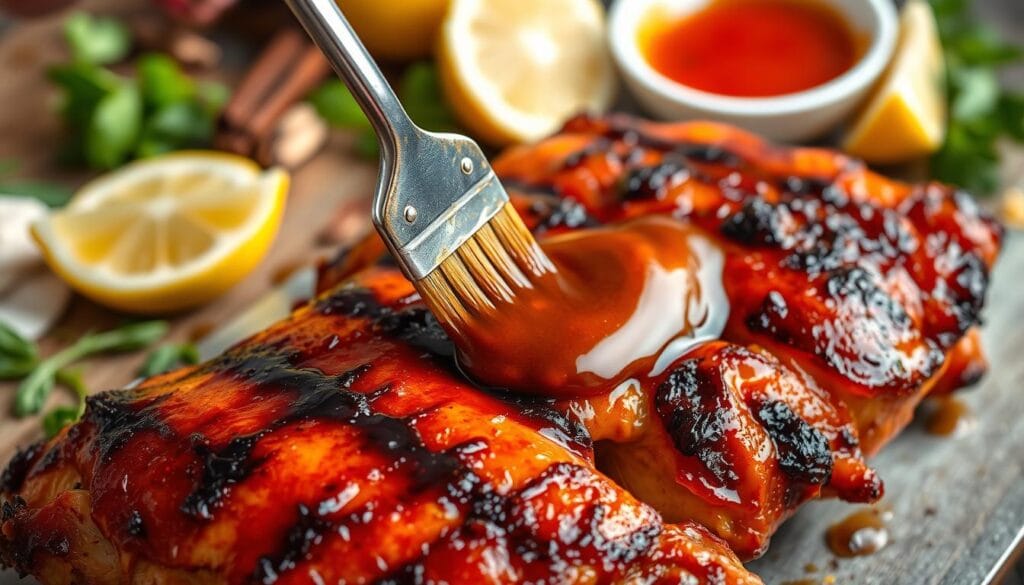
Homemade BBQ Sauce Recipes
Making your own barbecue sauce lets you control the taste. Here’s a simple yet tasty recipe:
- ½ cup ketchup
- ¼ cup brown sugar
- 2 tablespoons apple cider vinegar
- 1 tablespoon Worcestershire sauce
- 1 teaspoon garlic powder
- ½ teaspoon smoked paprika
Timing Your Glazes
Applying glaze at the right time is key for barbecue chicken. Wait until the last 10-15 minutes of smoking. This avoids burning and lets sugars caramelize.
Pro tip: Use a silicone basting brush for even sauce distribution and maximum flavor coverage.
For the final step, dip each chicken piece in BBQ sauce or brush it on. Then, return to the smoker for 10 minutes. This sets the glaze and adds a delicious caramelized layer.
Perfect barbecue chicken comes from patience and skill. Your homemade marinade and glaze will turn a simple smoked chicken into a masterpiece.
Common Smoking Mistakes to Avoid
Learning to smoke meat well means knowing what not to do. Both new and seasoned grillers can make mistakes that spoil the taste of smoked chicken. These errors can affect the quality of your dish.
The biggest mistakes in smoking chicken are:
- Using dirty smoke instead of thin blue smoke
- Incorrect temperature control
- Oversmoking the chicken
- Frequent smoker lid opening
- Neglecting internal temperature monitoring
Keeping the temperature right is key for smoking chicken. The U.S. Department of Agriculture says to cook poultry to at least 165 degrees Fahrenheit. Experts say to take chicken off the smoker at 160 degrees. This is because harmful bacteria are killed quickly at this temperature.
| Mistake | Consequence | Solution |
|---|---|---|
| Oversmoking | Bitter, burnt flavors | Use less wood, choose mild fruit woods |
| Wrong Temperature | Dry or undercooked meat | Maintain 275-325°F range |
| Constant Lid Opening | Heat and smoke loss | Minimize lid openings |
Chicken soaks up smoke flavors fast. Start with a little wood and add more as needed. Cold chicken works best for flavor. It’s best to move it from the fridge to the smoker.
Serving and Storage Tips
After making your tasty smoked chicken, it’s key to serve and store it right. This keeps the healthy protein’s flavor and quality top-notch. Your dish should be handled with care to keep its delicious taste.
Serving Recommendations
How you present your smoked chicken breast is important. Here are some elegant ways to serve it:
- Slice chicken against the grain for maximum tenderness
- Arrange on a warm platter with fresh herbs
- Pair with complementary side dishes like roasted vegetables
- Garnish with lemon wedges for a bright, fresh touch
Storage Guidelines
Keep your chicken’s quality up with these storage tips:
| Storage Method | Duration | Best Practices |
|---|---|---|
| Refrigerator | 3-4 days | Store in airtight container |
| Freezer | Up to 6 months | Wrap tightly in freezer-safe packaging |
Reheating Techniques
To keep your chicken moist when reheating, try these methods:
- Preheat oven to 275°F
- Add a splash of chicken broth to prevent drying
- Cover with foil to retain moisture
- Heat until internal temperature reaches 165°F
Pro tip: Avoid microwave reheating, which can toughen the meat and diminish its smoky flavor.
Conclusion
Mastering smoked chicken breast takes practice, patience, and precision. Start by learning key techniques like controlling temperature and choosing the right wood chips. Also, perfect your brining method.
These skills are essential for making high-protein, low-carb meals or grilled chicken variations. They will take your cooking to the next level.
Every time you smoke chicken, you’ll get better. Keep the temperature between 225°F and 250°F. Make sure the chicken reaches 165°F inside for safety and flavor.
Try different woods like hickory, apple, or mesquite to find your favorite taste.
Success comes from paying attention to every detail. Choose fresh chicken and season it well. Brine for moisture and let it rest for 15 minutes.
This way, you’ll make chicken breasts that taste like they’re from a restaurant. Keep trying new things and enjoy the tasty results of your smoking skills.
Smoking chicken is more than cooking. It’s about making meals that bring people together. Your smoker opens the door to endless culinary adventures and delicious experiences.


